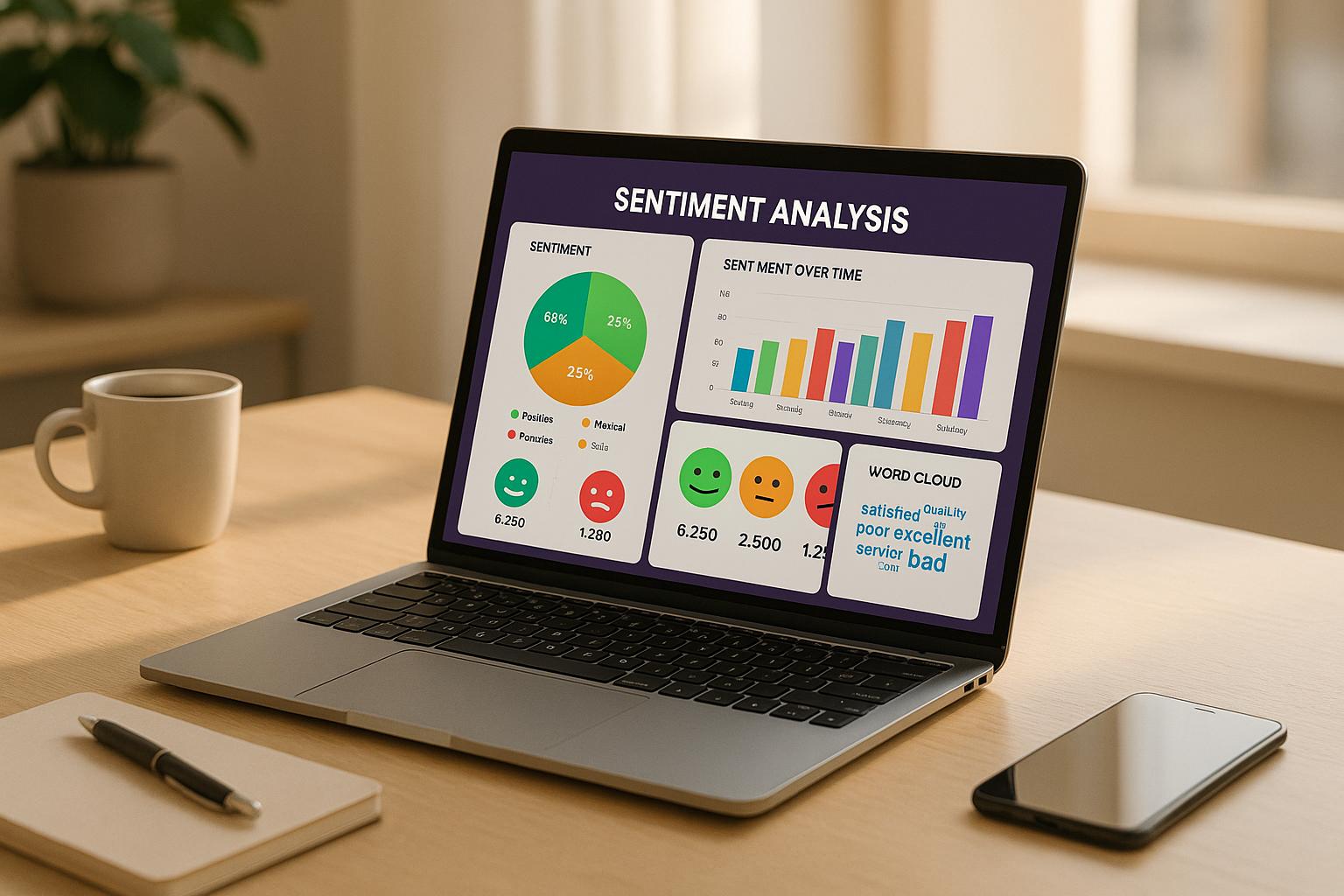
Customer sentiment analysis is now a must-have for ecommerce businesses in 2025. AI-powered tools can analyze customer feedback in real-time, helping businesses improve satisfaction, retain customers, and make better decisions. With the sentiment analysis market projected to reach $8.6 billion this year, these tools are essential for staying competitive.
Here’s a quick overview of the top 5 tools:
- Brandwatch Cortex: Tracks emotions across social media and customer service platforms with multilingual support. Pricing starts at $800/month.
- Chattermill: Centralizes feedback from surveys, reviews, and chats. Offers predictive insights and supports over 100 languages. Pricing starts at $990/month.
- Lexalytics: Combines AI and rules-based processing for retail-specific sentiment analysis. Custom pricing based on usage.
- Sentiment360: Provides real-time feedback insights and multilingual analysis for global ecommerce brands. Custom pricing available.
- Sobot Chatbot: Analyzes customer emotions during interactions and automates responses. Pricing starts at $30/month for small businesses.
These tools help brands understand customer emotions, identify issues early, and personalize experiences. Whether you’re a startup or a large enterprise, there’s a solution to fit your needs. Below, we’ll dive deeper into each tool.
What Are The Best Tools For Real-Time Sentiment Analysis? – Next LVL Programming
1. Brandwatch Cortex
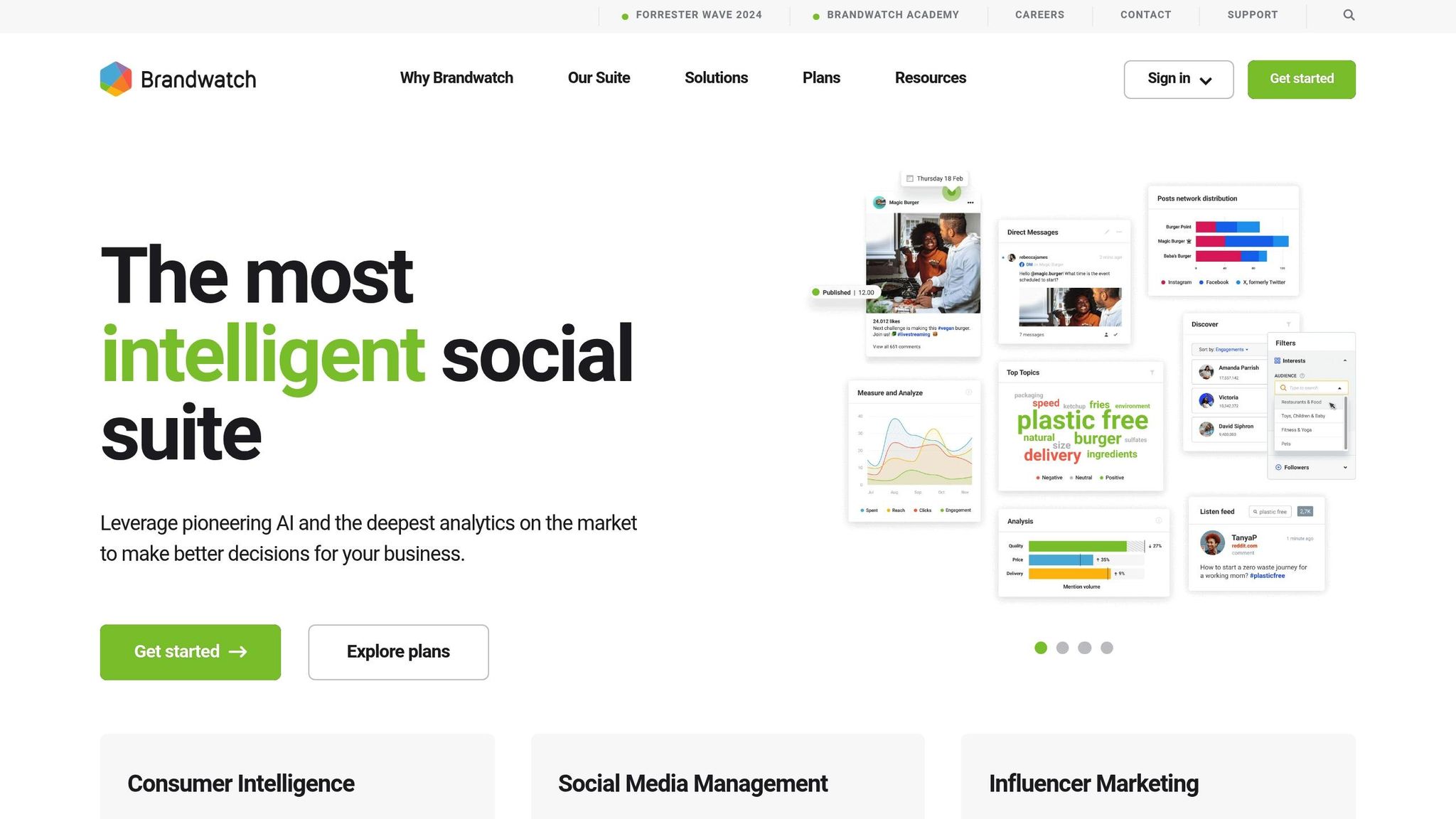
Brandwatch Cortex is an AI-powered sentiment analysis platform designed to capture the emotional nuances of customer interactions. It’s particularly helpful for ecommerce businesses juggling multiple channels and touchpoints, making it a valuable tool in understanding customer sentiment across platforms.
AI-Driven Sentiment Analysis
This platform uses advanced AI to identify six key emotions – anger, disgust, fear, joy, sadness, and surprise. It’s also equipped to interpret slang, dialects, and even emojis. By analyzing the full context of messages, including word order, negations, syntax, and case sensitivity, Brandwatch Cortex achieves an average accuracy improvement of 18% across supported languages. Its sentiment accuracy typically falls between 60–75%. The tool integrates seamlessly with major platforms like Twitter, Facebook, and Instagram, as well as customer service systems such as Zendesk and Salesforce.
Multilingual Support
For global businesses, Brandwatch Cortex offers sentiment analysis in over 40 officially supported languages and can classify sentiment in nearly any language. Its approach goes beyond simple translation, accounting for cultural nuances and context-specific expressions that influence sentiment interpretation.
Real-Time Insights
Brandwatch Cortex provides real-time insights to help businesses respond quickly. Custom dashboards spotlight trends and anomalies as they happen, while benchmark settings and alerts notify users of deviations from normal patterns, enabling proactive decision-making.
"Brandwatch Cortex is a strong choice for companies that need a comprehensive social media monitoring and analytics platform."
– Forrester
Pricing and Scalability
The platform offers flexible pricing, ranging from $800 to $3,000 per month, depending on features and usage. For instance, the Pro plan starts at $800 and includes 10,000 mentions, while Enterprise plans begin at $3,000+ and offer unlimited mentions and queries. Brandwatch Cortex is designed to scale, catering to both small startups and large enterprises.
"Given the cost of it, you will want to make sure those people are engaged at least at a … level in the company to know how to best search. It does not have a low cost, so it might not work for many smaller businesses…"
– James Arnold, Chief Digital Officer, Rooster Strategic Solutions
While the price may be steep for some smaller businesses, 75% of companies see social media monitoring as a critical part of their sentiment analysis strategy. Additionally, 90% believe AI-driven sentiment analysis is essential for understanding customer emotions. For ecommerce businesses handling high volumes of customer interactions, the investment can lead to better customer satisfaction and retention.
2. Chattermill
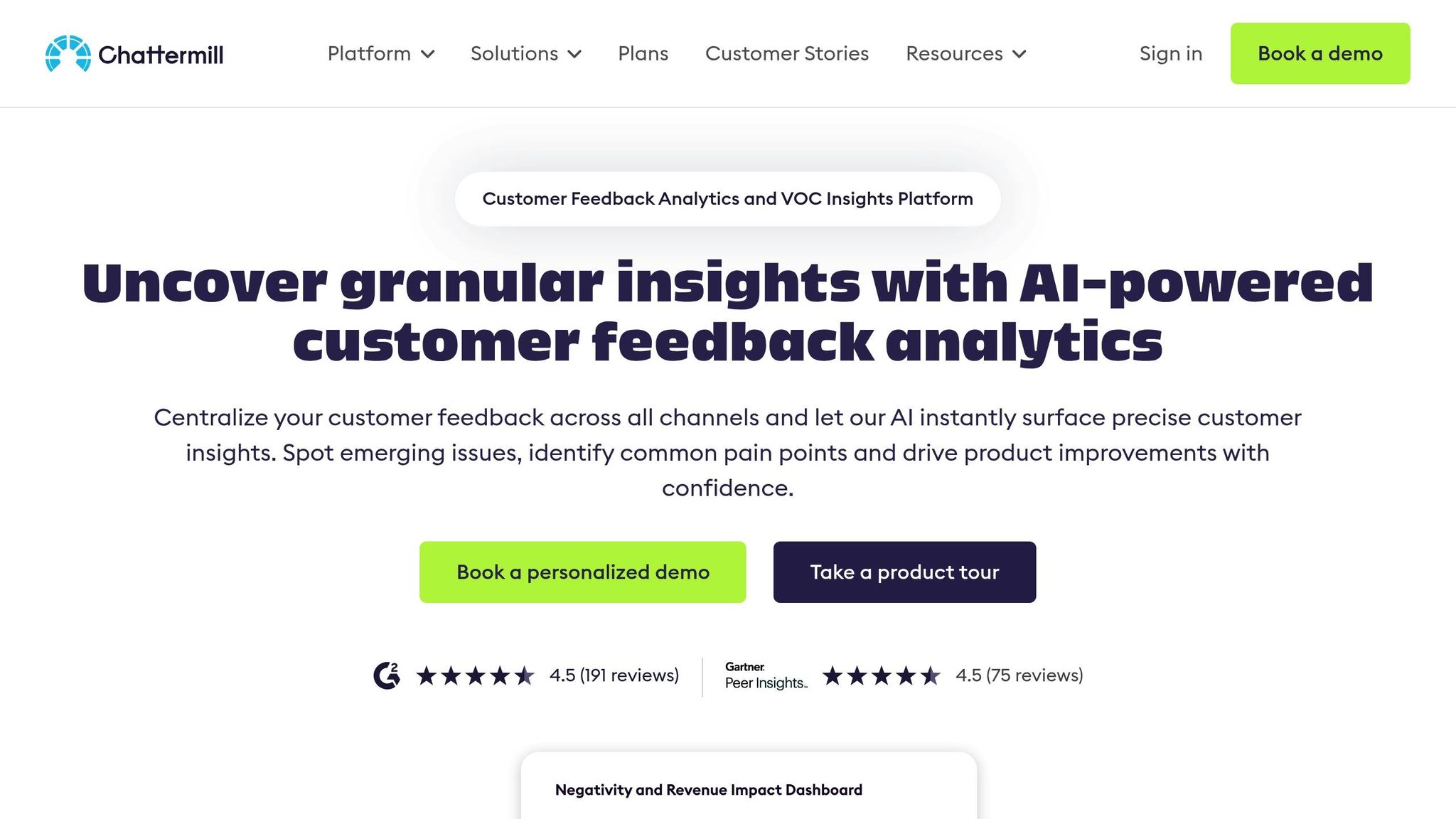
Chattermill takes a different approach from platforms like Brandwatch Cortex by bringing together various types of customer feedback into a single, unified system. Instead of dealing with fragmented data from multiple tools, businesses can view everything – surveys, reviews, social media comments, support chats, and even call transcripts – on one centralized dashboard.
AI-Driven Sentiment Analysis
Chattermill uses AI to dig deep into customer feedback, uncovering the reasons behind their feelings and offering predictive insights to help businesses act before issues like churn arise. Research indicates that AI-powered sentiment analysis can improve customer satisfaction by 25% and increase brand loyalty by 30%. For example, one company saw a 42% drop in customer contacts per transaction, boosted its Trustpilot score from 3.9 to 4.4, and maintained a high Net Promoter Score (NPS) of 80.
"Customer feedback insights from Chattermill have driven key changes, unlocking new revenue streams, brands, and expanded product options." – Stefan Platteau, Director of Global Product Strategy and Analytics
The platform turns unstructured feedback into actionable data, helping teams across customer experience, support, product development, and operations make smarter decisions.
Multilingual Support
For businesses with a global reach, Chattermill’s multilingual capabilities are a game-changer. It can analyze feedback in over 100 languages, displaying comments in both English and the original language. Users can choose their preferred translation settings, making it easier to understand customer sentiment across different regions. Considering that global ecommerce sales have surpassed $5.5 trillion and 95% of shoppers read reviews before making a purchase, this feature is vital for staying connected with a diverse customer base.
Real-Time Insights
One of Chattermill’s standout features is its ability to provide real-time insights. Instead of waiting weeks for traditional reports, businesses can address issues as they happen. This is especially important in ecommerce, where customer sentiment can shift quickly due to factors like product launches or shipping delays.
"If you’re serious about understanding and improving customer journeys, Chattermill is essential." – James McGhee, Director of Customer Experience
With real-time analytics, teams – from customer service to product management – can make quick, informed decisions. This not only helps resolve immediate concerns but also highlights recurring problems that need long-term solutions.
Pricing and Scalability
Chattermill’s pricing starts at $990 per month, with custom packages available for international and fast-growing brands.
"To deliver amazing experiences, we rely on customer feedback. Chattermill empowers all teams to make informed decisions anytime." – Julia Zuber, Senior Customer Insights Manager
With an impressive 4.5/5 rating on G2 (191 reviews) and Gartner (75 reviews), Chattermill has demonstrated its value for companies looking to streamline and scale their feedback analysis efforts.
3. Lexalytics
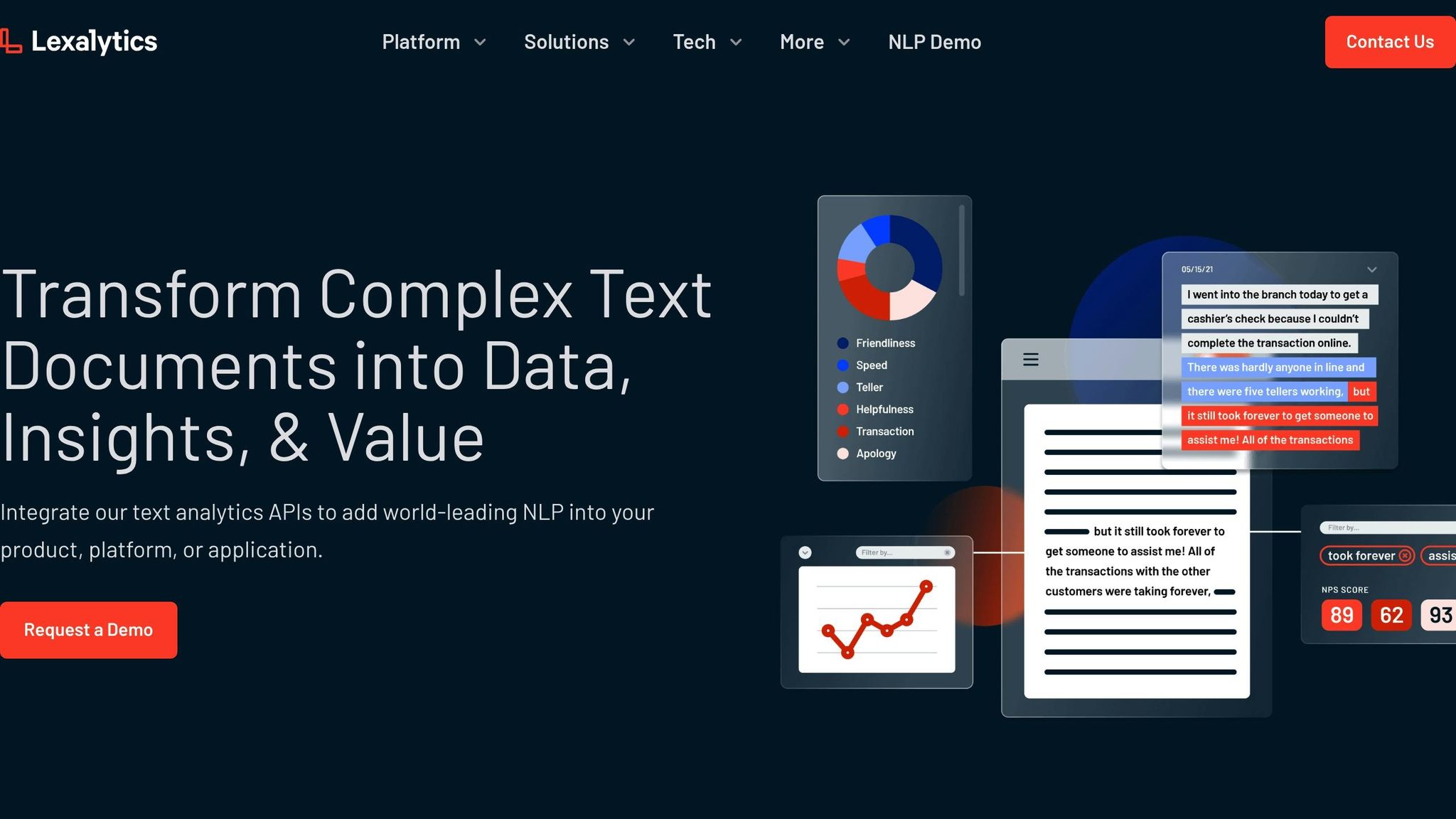
Lexalytics takes a hybrid approach by combining machine learning with rules-based processing. This blend allows businesses to customize sentiment analysis quickly – often in just hours rather than weeks. By leveraging established AI frameworks, Lexalytics tailors its sentiment analysis specifically to meet the unique challenges of ecommerce.
AI-Driven Sentiment Analysis
With its eCommerce Industry Pack, Lexalytics offers over 100 ecommerce-specific entities and 4,800 sentiment phrases, enabling precise analysis of retail feedback. The platform also detects customer intentions, such as buying, selling, quitting, or recommending.
"As the eCommerce industry continues to boom and mature, marketers need an easy way to analyze the deluge of data around customer experience to ensure their site is more efficient, easier to use and more interesting than any of the latest crop of ‘exciting’ startups. We can help them ensure that any issues are quickly addressed while they’re still manageable, well before they get to the point that customers and careers are adversely affected." – Jeff Catlin, CEO of Lexalytics
In tests involving over 1,000 documents, Lexalytics achieved an impressive 87% agreement with human annotators. This high level of accuracy ensures businesses can rely on the insights derived from customer feedback. On top of that, its global language capabilities make it a versatile tool for companies with diverse customer bases.
Multilingual Support
For ecommerce businesses operating in international markets, Lexalytics provides native language support in 29 languages, covering 67% of the global population across six continents. This feature is crucial, given that 72% of consumers prefer content in their native language.
"Analyze content in a majority of languages spoken worldwide; Lexalytics processes text in 22 languages and counting for global brands" – Lexalytics
This multilingual capability allows businesses to analyze customer feedback worldwide without losing the subtle context that language and culture provide. It’s especially beneficial for ecommerce brands venturing into new markets or managing a diverse international audience.
Pricing and Scalability
Lexalytics offers a tailored pricing model based on data volume and required features, making it adaptable to a variety of business needs. However, pricing details require direct consultation for a custom quote.
The platform is built to handle large-scale data processing, making it a strong fit for growing ecommerce businesses. That said, companies should plan for additional costs beyond licensing fees. Implementation expenses may include data preparation, model customization, staff training, and ongoing maintenance to ensure consistent performance.
Lexalytics aggregates feedback from sources like reviews, surveys, and social media, helping businesses identify key issues such as shipping delays or checkout problems. This functionality ensures that ecommerce brands can address operational challenges efficiently while improving the overall customer experience.
sbb-itb-e2944f4
4. Sentiment360

Sentiment360 is a sentiment analysis platform tailored for ecommerce businesses that interact with customers across multiple channels. Its goal? To transform raw feedback into meaningful insights that drive better decision-making.
Emotions play a massive role in what customers buy. Research shows that 70% of purchase decisions are driven by emotional factors, while only 30% are based on logic. This highlights why tools like Sentiment360 are so important for modern ecommerce.
"People will forget what you said, people will forget what you did, but people will never forget how you made them feel." – Maya Angelou, American poet and activist
This quote perfectly explains why sentiment analysis has evolved from just identifying positive or negative feedback to becoming a strategic tool for businesses. Sentiment360 is an example of how far this field has come.
Real-time Insights
One of Sentiment360’s standout features is its ability to provide real-time insights. Its live dashboard notifies teams about shifting customer sentiment, allowing them to address issues as they arise. For instance, if customers start expressing dissatisfaction with product quality, shipping delays, or poor service, ecommerce teams can act quickly to resolve the problem before it escalates.
This instant feedback loop is particularly important for businesses where sentiment can change rapidly, ensuring they stay ahead of potential challenges.
Multilingual Support
For ecommerce brands operating globally, Sentiment360 offers analytics in multiple languages. It doesn’t just translate; it interprets cultural subtleties that are essential for understanding customer sentiment accurately. Multilingual systems like this can achieve up to 90% accuracy, compared to just 70% for single-language models.
The ability to grasp local expressions and regional differences has proven effective. Companies using multilingual sentiment analysis have reported a 25% boost in user engagement, as they can better connect with customers in their native languages.
AI-driven Sentiment Analysis
Sentiment360 uses advanced AI and natural language processing (NLP) to dig deeper into customer sentiment. By leveraging transformer-based architectures and multilingual embeddings, the platform ensures accurate sentiment interpretation across languages and contexts.
This means it can pick up on idiomatic expressions and cultural references that might otherwise be misinterpreted, making it a powerful tool for understanding diverse customer bases.
Pricing and Scalability
Sentiment360 is built to grow with your business. While pricing details are customized based on specific needs, the platform is designed to handle the demands of expanding ecommerce operations. It efficiently processes large datasets, making it ideal for businesses collecting feedback from multiple channels.
Its CRM and support tool integration ensures that sentiment insights fit seamlessly into existing workflows. For ecommerce brands juggling multiple systems, this feature simplifies operations by streamlining how insights are used.
The platform also supports sentiment analysis across various sources – social media, reviews, surveys, and direct communications – giving businesses a complete view of how customers feel at every touchpoint. This comprehensive approach helps brands stay connected to their audience and respond effectively to their needs.
5. Sobot Chatbot
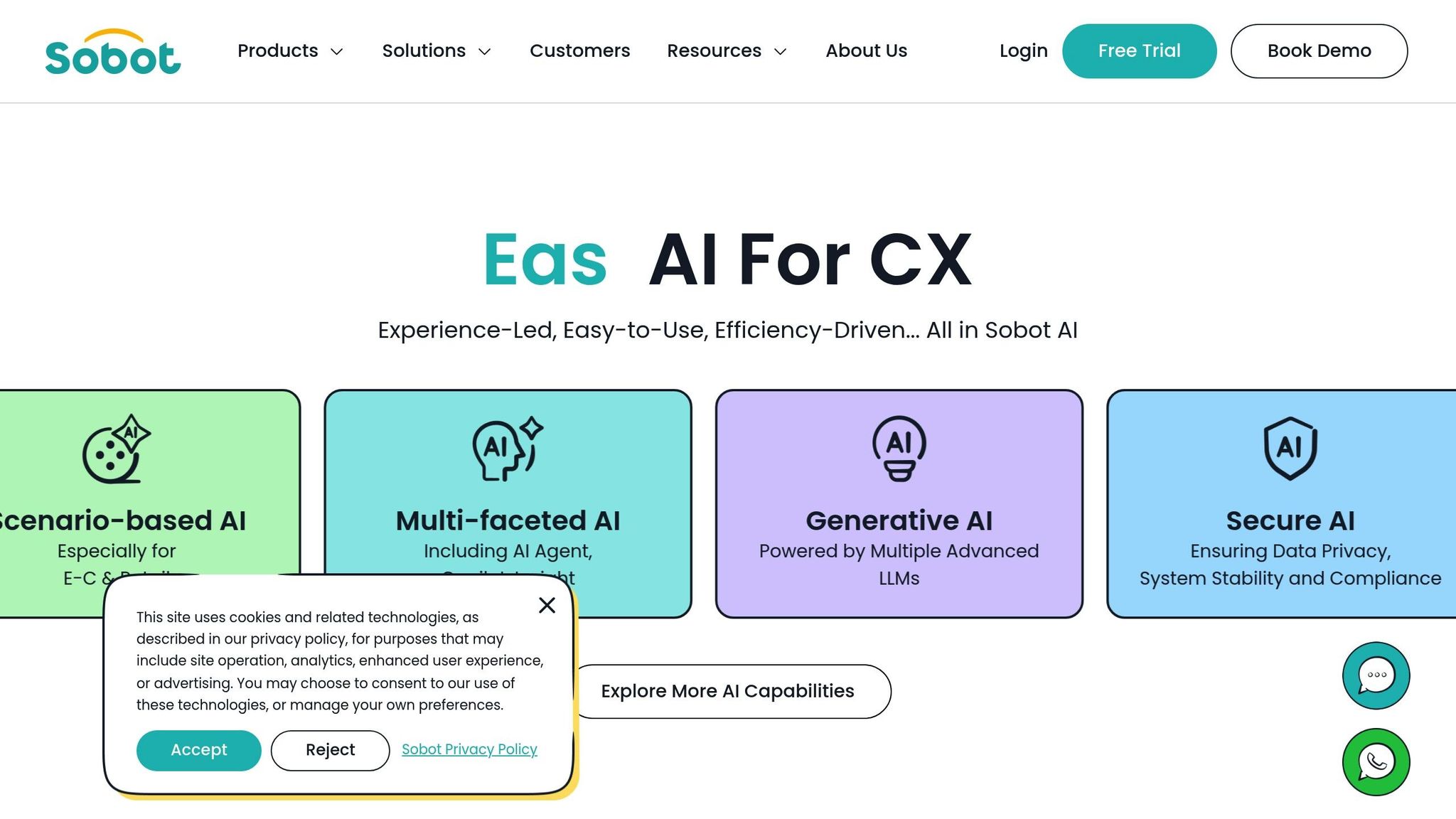
Sobot Chatbot combines AI-powered sentiment analysis with automation to deliver a more personalized customer experience. Unlike traditional chatbots that simply answer questions, Sobot actively tracks and interprets customer emotions during interactions. This makes it a powerful tool for ecommerce businesses aiming to better understand and respond to customer sentiment.
By analyzing conversations across multiple channels, Sobot doesn’t just rely on keywords – it examines tone and context to provide businesses with insights into how customers feel and their overall satisfaction. This blend of sentiment analysis and automation gives companies a competitive edge in customer service.
AI-driven Sentiment Analysis
Sobot’s AI can identify the emotions behind customer messages, offering a deeper understanding of their concerns and needs. For instance, Agilent, a life sciences and diagnostics company, adopted Sobot’s AI-driven chatbot along with its omnichannel workbench. The result? A sixfold boost in customer service efficiency as the chatbot handled routine inquiries, enabling human agents to focus on more complex issues.
Real-time Insights
Sobot takes its sentiment analysis a step further with live feedback through its dashboard. This real-time tracking allows businesses to respond quickly to shifts in customer emotions. Immediate responses can increase revenue by as much as 15%, and according to HubSpot, 90% of customers consider a response within 10 minutes to be very important. In February 2025, OPPO implemented Sobot’s chatbot to handle repetitive queries, achieving an impressive 83% resolution rate and a 94% positive feedback rate.
Multilingual Support
For ecommerce brands catering to a global audience, Sobot offers multilingual support, ensuring accurate sentiment analysis across different languages and regions. This feature allows businesses to connect with customers worldwide while addressing cultural nuances effectively. Research shows that AI-powered chatbots like Sobot can handle up to 70% of routine queries, freeing up human agents to tackle more complex and sensitive interactions.
Pricing and Scalability
Sobot provides flexible pricing options tailored to different business sizes. Small and medium businesses can start with plans as low as $30 per month. Mid-market companies can choose scalable monthly plans, while larger enterprises have access to custom solutions that include integrations, multilingual support, and 24/7 operations. With both subscription-based and usage-based pricing models, Sobot makes it easy to manage seasonal spikes in demand. Users have reported up to a 95% satisfaction rate and a 2.5× increase in inquiry handling during peak times. This transparent pricing helps businesses control costs while maximizing their return on investment, making Sobot a smart choice for long-term growth.
Tool Comparison Chart
Selecting the right sentiment analysis tool for your ecommerce business can be tricky. To simplify the process, here’s a comparison of key features, pricing, and ideal use cases for some popular tools:
| Tool | Key Features | Pricing (USD) | Best For | Notable Results |
|---|---|---|---|---|
| Brandwatch Cortex | Social media monitoring, brand sentiment tracking, comprehensive analytics platform | Pro: $500/month Enterprise: $1,000/month |
Large enterprises, social media-focused brands | Great for in-depth social media monitoring and analytics |
| Chattermill | Unified customer feedback analysis, actionable insights, multi-channel support | Custom quote required | Telecom, customer experience teams | Reported a 25% increase in positive feedback and improved NPS scores |
| Lexalytics | Industry-specific customization, multilingual analysis, deep language processing | Custom quote required | Hospitality, retail, enterprise | Helped hotels enhance guest experiences through tailored solutions |
| Sobot Chatbot | AI-driven analysis, real-time insights, multilingual support, omnichannel integration | Starting at $30/month for SMBs Custom enterprise solutions |
Retail, ecommerce, finance, gaming | Achieved 40% cost reduction (Klarna) and 43% ticket deflection (Motel Rocks) |
This table highlights the differences in features, pricing, and best-fit scenarios, making it easier to align a tool with your business needs. For example, Sobot Chatbot starts at just $30/month, making it an affordable choice for smaller businesses, while Brandwatch Cortex offers fixed plans ranging from $500 to $1,000/month. Tools like Chattermill and Lexalytics, on the other hand, require custom quotes, typically catering to businesses with specific needs.
Integration capabilities also play a big role. Some tools have been credited with improving customer retention by as much as 62%, and seamless system integration is often a deciding factor for many businesses. Additionally, sentiment analysis accuracy has seen massive improvements – from 60% in 2015 to over 90% by 2025 – making these tools much more dependable for guiding decisions.
Your choice should depend on your business size, budget, and technical requirements. Companies leveraging AI for customer experience often enjoy a 25% boost in revenue. This makes effective sentiment analysis more than just a nice-to-have – it’s a key driver of competitive advantage. For instance, while premium tools like Brandwatch Cortex cater to large enterprises, smaller businesses might find exceptional value in cost-effective options like Sobot Chatbot, as proven by successful cases like Klarna and Motel Rocks.
When evaluating tools, think about your current customer volume, growth plans, and specific needs. The most expensive option isn’t always the best – sometimes, the right fit is the one that aligns perfectly with your goals.
Conclusion
As we look ahead to 2025, customer sentiment analysis is no longer a luxury – it’s a necessity for ecommerce businesses aiming to stay competitive. With the global AI sentiment analysis market expected to hit $10.6 billion by 2025, growing at an impressive 34.5% annually, relying on instincts alone for customer experience decisions is simply not enough.
The numbers speak for themselves. Businesses using real-time sentiment analysis are 2.4 times more likely to surpass customer satisfaction targets. Additionally, 62% of companies have reported improved customer retention after adopting sentiment analysis tools. These insights highlight just how powerful these tools can be in shaping customer relationships.
From budget-friendly options like Sobot Chatbot to high-end solutions such as Brandwatch Cortex (starting at $1,000 per month), there’s a tool for every business size and need. The challenge lies in choosing the one that aligns with your specific requirements. Factors like data volume, integration capabilities, and budget should guide your decision-making process.
Take the time to assess your customer feedback channels, future growth plans, and technical capabilities. The right sentiment analysis tool can turn raw customer feedback into actionable strategies, giving your business a competitive edge. By investing in these tools, ecommerce brands can transform customer insights into meaningful actions, driving long-term success.
FAQs
What should I consider when choosing a sentiment analysis tool for my ecommerce business in 2025?
When picking a sentiment analysis tool for your ecommerce business in 2025, aim for one that offers exceptional accuracy – preferably over 90% – and includes multilingual support to connect with a broad and diverse audience. Features like real-time analysis, insights from customer reviews and social media, and smooth integration with your existing systems are key to keeping operations efficient and effective.
It’s also important to choose a tool that matches your specific objectives. Whether you’re tracking emotional trends, tailoring customer interactions, or acting on feedback to refine the shopping experience, selecting the right tool can help you make smarter, data-driven decisions and keep your customers happy.
What makes AI-powered sentiment analysis tools better than traditional methods?
AI-powered sentiment analysis tools offer a way to gain insights quickly and efficiently, far outpacing traditional methods. They can sift through massive amounts of customer feedback – whether it’s social media chatter, online reviews, or survey responses – in no time, helping businesses save precious hours.
What sets these tools apart is their ability to pick up on the subtle layers of language, like sarcasm, slang, or irony, which are often overlooked by older techniques. With these deeper, data-driven insights, businesses are better equipped to make informed decisions, boost customer satisfaction, and focus on the changes that resonate most with their audience.
Why is multilingual support essential in sentiment analysis tools for global ecommerce businesses?
Multilingual support plays a key role for global ecommerce businesses, enabling accurate analysis of customer feedback across various languages and cultural contexts. This ability helps companies grasp customer emotions, refine their strategies, and enhance experiences for audiences worldwide.
By 2025, top sentiment analysis tools come with real-time multilingual capabilities, simplifying global expansion for brands. These tools allow businesses to analyze feedback in different languages, spot trends, tackle issues, and foster deeper connections with their diverse customer base.
